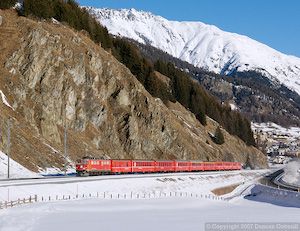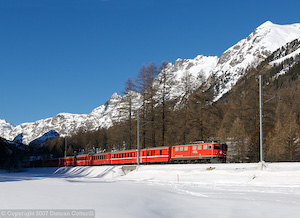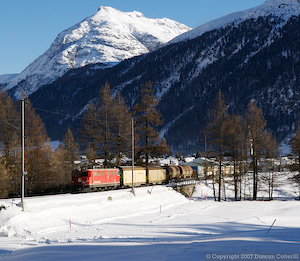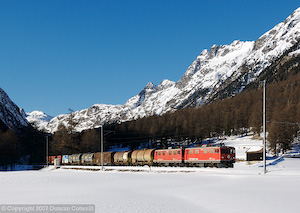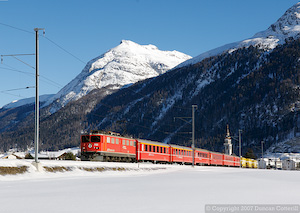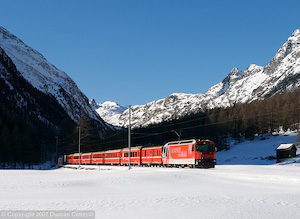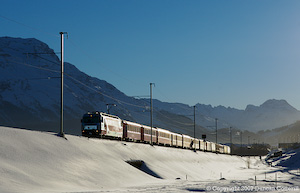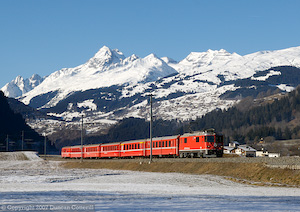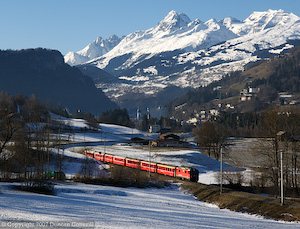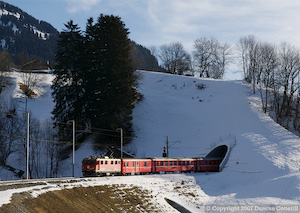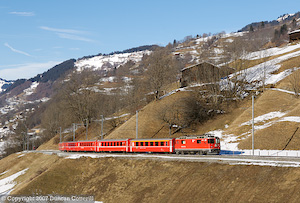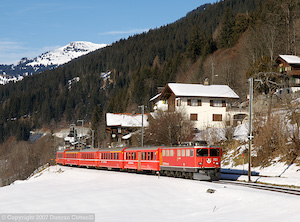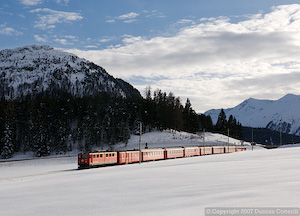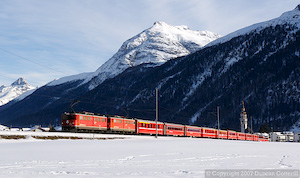Winter on the Rhätischebahn
19 - 23 December 2007
Report by Duncan Cotterill
Introduction
Winter in the Swiss Alps attracts skiers and snowboarders in huge numbers but what would it be like for a railway photographer? In spite of doubts about the weather, I decided to visit the Rhätischebahn from 19 to 23 December to find out.
My base for the trip was the Hotel Grischuna, next to the station in Filisur, and I used a Swiss Pass to get around, taking advantage of the free first class upgrade offer that ran until 23 December.
The railway serves the south-eastern canton of Graubünden with a network of metre-gauge lines that climb high into the Alps, serving the upmarket resorts of Klosters, Davos and St. Moritz as well as many more attractive and largely unspoilt villages. See my October 2007 report for more details of the line.
The Albula Line
Passenger Trains
The principal service on this line consists of hourly RegioExpress (RE) trains between Chur and St Moritz. These are usually hauled by the class Ge4/4III “Werbeloks” in advertising liveries. Regular locos on the line were 644, 646, 647, 649 and 651.
Fortunately the Werbeloks didn’t have a complete monopoly. One improvement since the timetable change in early December has been the introduction of a regular turn for a Class Ge4/4II on trains 1110 (Mo-Fr), RE1121, RE1136, RE1145, RE1160 and 1169. Ge6/6IIs 707 and 701 covered this turn on Thursday 20 and Sunday 23 December respectively. Another Ge6/6II, 705, covered one of the Ge4/4III turns on the Thursday, making the Albula the place to be on that day. The Sunday was also notable as Ge6/6II 702 worked an early morning special to St. Moritz and returned piloting 701 on train RE1136.
At the bottom end of the line the hourly Chur – Thusis and Schiers – Rhäzhüns locals were worked by class Be4/4 motor coaches as before.
Tourist Trains
The Glacier Express and Bernina Express operations were much reduced from October. A single Glacier Express section ran attached to trains RE1128 and RE1153 from St. Moritz to Chur and v.v. and a single Bernina Express section ran from Chur to Samedan and v.v. attached to trains RE1125 and RE1156. From Samedan to Pontresina the Bernina section was taken forward by the train engine while the St. Moritz section continued behind a Ge4/4I or a Ge6/6II.
Winter Sports Trains
The road between Preda and Bergün is turned into a sledging run in winter and an hourly shuttle service runs between the two stations to take the sledgers back up the hill. This service started on Saturday 22 December and was worked by Ge4/4I 604 on the Preda end of a push-pull set on both the Saturday and the Sunday.
Freight Trains
Freight traffic was reasonably heavy with two daylight trains each way over the line on most weekdays. There were no daylight workings at weekends. In addition to the freights, container wagons or vans were sometimes attached to the back of passenger trains. The heavier freights were usually hauled by class Ge6/6IIs with Ge4/4Is on some of the lighter trains. On Thursday 20 December Ge4/4Is 604 & 608 were paired on freight 5135 from Landquart to Pontresina and on Friday 21 December the same pair worked freight 5129 from Chur to Samedan. This might have been due to the number of Ge6/6IIs covering passenger workings on those days.
The Filisur – Davos Line
Passenger Trains
The hourly local trains continue to be worked by class Ge4/4Is on push-pull sets with the loco always at the Davos end of the formation. During my visit, 609 was the regular loco on these trains with 602 and 606 making occasional appearances.
The Davos portions of the Glacier and Bernina Expresses don’t run in winter and no freight was seen on the line either.
The Scuol-Tarasp – Disentis Line
Passenger Trains
The hourly passenger service continued to be dominated by Ge4/4II locos on hauled stock but at least one Ge6/6II was also used each day except Sunday. Locos 612, 613, 614, 617, 618, 622, 623, 626, 627, 628 and 630 were joined by Ge6/6IIs 701, 702 and 707.
Tourist Trains
A single Glacier Express section ran from Chur to Disentis and v.v. each day hauled by a Ge4/4II.
Freight Trains
Freight traffic between Landquart and Disentis can be heavy but it was virtually non-existent on Friday 21 December. Neither of the two Landquart – Ilanz return trips operated and the morning Disentis – Landquart train was a light engine west of Ilanz.
The Scuol-Tarasp – Pontresina Line
Passenger Trains
Passenger services continue to be operated by class Ge4/4II locos on push pull sets. The early morning working with a Ge4/4I noted in October was regularly Ge4/4II this time. As before, the loco was always coupled to the Scuol end of the stock. Locos 615, 616, 619 and 629 were regulars on these services.
Freight Trains
A pair of Ge4/4Is worked a timber train from Zernez to Pontresina on the afternoon of Wednesday 19 December but this was probably a one-off as it doesn’t appear in the timetable.
The Landquart – Klosters - Davos Line
Passenger Trains
Most passenger trains were worked by class Ge4/4III locos coupled to the Davos end of push-pull sets. The regular engines were 641, 648 and 650.
A few early and late trains, namely 1008, 1012, 1013, RE1065, 1072, 1077 and 1081 appeared to be booked for class Ge4/4II locos but Ge6/6II and Ge4/4I could also appear. These workings were formed of hauled stock rather than push-pull sets.
Saturday 22 December was a busy day for the RhB with many people travelling to Graubünden for the Christmas break and additional coaches were required on the Davos trains. An additional hauled set was in use with Ge4/4I 605 working RE1028 from Davos and Ge6/6II 703 in charge for the rest of the day. This allowed the usual seven minute turnround at Davos to be extended to an hour and seven minutes so there was time for the additional coaches to be shunted to the back of the push-pull sets.
Winter Sports Trains
From 22 December until 8 March an additional hourly service runs between Klosters Dorf and Davos Platz calling at all stations. Two push-pull sets are required for this and on Saturday 22 December they were worked by Ge4/4Is 603 and 610, both coupled to the Davos end of their trains.
Vereina Tunnel Car Shuttles
Three class Ge4/4III locos were allocated to these push-pull trains with the loco coupled to the Selfranga (Klosters) end of the stock and a driving trailer at the Sagliains end. Locos 642, 643 and 645 were the regular power for these trains.
Loco Diagrams
For such a small operation, the Rhätischebahn seems to put a lot of effort into diagramming its locos. There are pools of locos that spend extended periods dedicated to particular services and regular daily diagrams but which loco will work which day of the diagram is less easy to predict. There are also the surprise substitutions that make life much more interesting, for instance when a class Ge6/6II covers a Chur – St. Moritz diagram for the day.
Although locos of classes Ge4/4II and Ge4/4III are booked to work most of the RhB’s passenger trains, there were plenty of Ge4/4Is and Ge6/6IIs on passenger work as well. It's just a bit more difficult to predict when they will turn up. During the trip all seven of the Ge6/6IIs and nine of the ten Ge4/4Is did some passenger work but the actual duties varied considerably from day to day.
Photography
Much of Switzerland was dull and foggy during my visit but the grot seemed to stop at the Graubünden border. In the mountains the weather couldn’t have been much better with snow on the ground and clear blue sky most of the time. Temperatures ranged from around freezing to –10°C but with little wind, it didn’t feel cold at all.
While the short days and low sun made photography difficult in places, there were still plenty of good photspots to choose from. Few locations were lit before 09:00 or after 15:00 and a good map was essential to work out which places might get the sun early or late in the day.
Getting around in the snow generally wasn't too difficult as many of the footpaths had been cleared and there were plenty of locals and visitors out walking. In the fields, the snow was often deep enough to make walking longer distances tiring, particularly if you were in a hurry.
A form of apartheid has been introduced around Davos with signs warning of dire consequences if non-skiers trespassed on ski tracks. People without planks attached to their feet are definitely second class citizens in Davos.
Deciding where to go each day turned out to be surprisingly easy and was determined largely by where the Ge4/4Is and Ge6/6IIs were working. Being able to see the following day’s plan every evening at Filisur or Bergün stations made this possible.
A Journey to Remember
After 5 days when the RhB and SBB provided punctual and efficient transportation, I returned to Zürich Flughafen to catch my flight home. The first sign that something was wrong was the departure board showing the 13:20 flight to Heathrow as boarding, at 17:00! Other flights to Heathrow and London City were shown as cancelled or severely delayed. Thick fog in the south-east was blamed.
My own flight to Gatwick eventually took off over 3 hours late, after several false starts, and I wondered if I would get home that night. Fortunately, we got in just in time for me to run for the last train. My luggage arrived on Christmas day. An imperfect end to a near perfect trip.
Conclusions
What a fabulous railway! After two visits I’m well and truly hooked on this wonderful line. It was good in October and the snow made it even better in December.
My favourite engines, the Ge4/4Is and Ge6/6IIs, were very active and the availability of information on which engines would work which trains made it possible to target the most interesting workings.
It was surprising how few enthusiasts were around given the excellent conditions. The Wilkinsons were in residence at Filisur but there didn't seem to be anybody else out photographing the trains.
